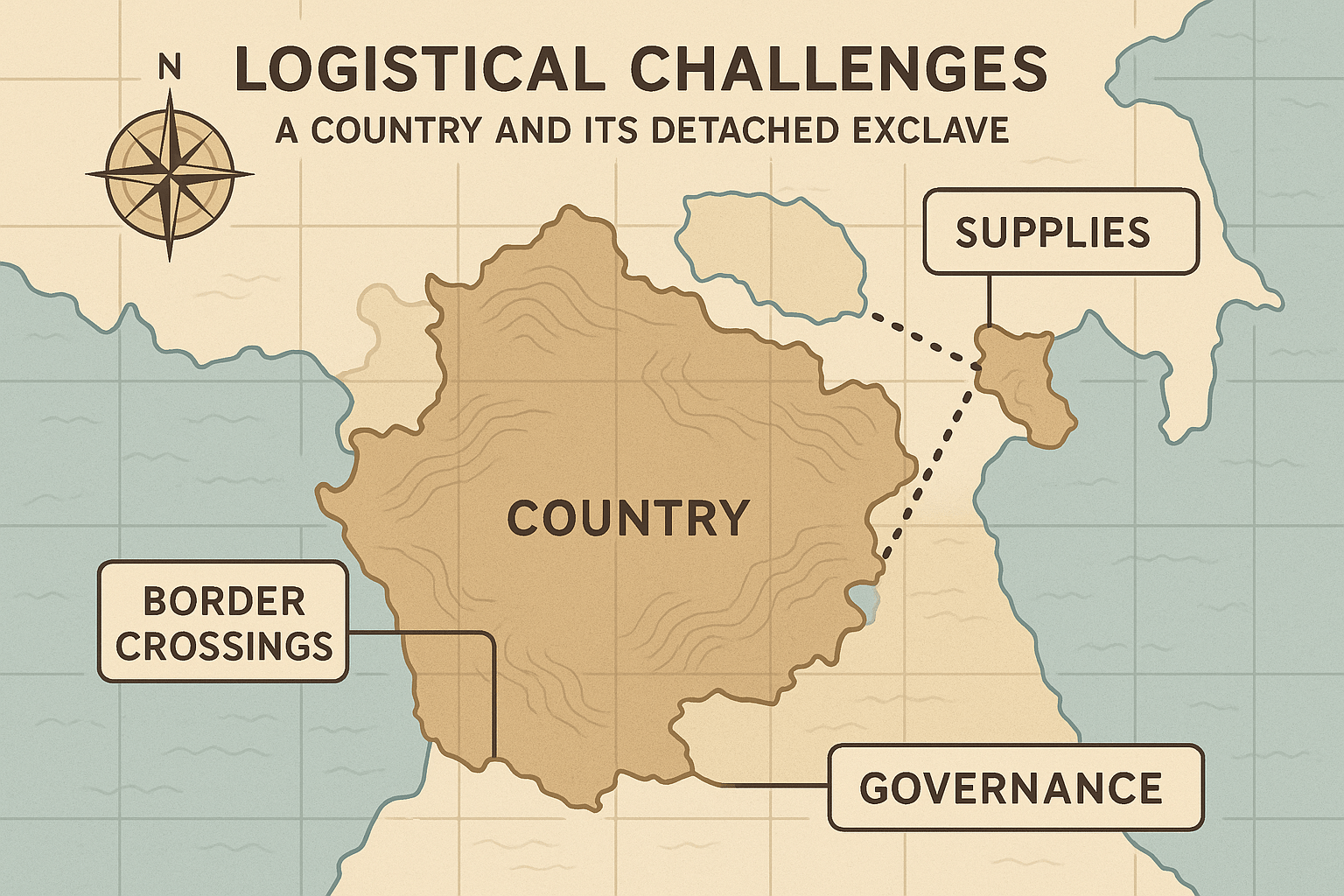Imagine your hometown is an island. Now, imagine that instead of being surrounded by water, it’s completely encircled by a foreign country. You are a citizen of Country A, but to get to any other part of Country A, you must cross through Country B. This isn’t a hypothetical riddle; it’s the strange, lived reality for millions of people residing in exclaves—the world’s geopolitical islands.
These territorial oddities are more than just cartographical curiosities. They are living, breathing communities where the abstract lines of a map dictate the rhythm of daily life, forge unique identities, and create challenges most of us can barely comprehend.
First, a Quick Geography Lesson: Exclave vs. Enclave
Before we dive in, let’s clear up some geographical jargon that often gets confused. While related, “exclave” and “enclave” describe different perspectives of the same phenomenon.
- An exclave is a portion of a country that is geographically separated from its mainland, surrounded by the territory of one or more other nations. Think of it from the “mother country’s” point of view—it’s an excluded piece of territory.
- An enclave is a territory that is entirely surrounded by the territory of one other country. Think of it from the “host country’s” point of view—it’s a piece of foreign land enclosed within its borders.
So, a territory can be both at once. Llívia, a small town that is part of Spain, is an exclave of Spain and an enclave within France. However, not all exclaves are enclaves. Kaliningrad is a Russian exclave, but since it borders both Poland and Lithuania (and has a coastline), it’s not an enclave in a single country. These geopolitical quirks are the result of centuries of treaties, wars, royal land swaps, and messy border negotiations that have left behind a fragmented map.
The Macro-Exclave: Kaliningrad, Russia’s Baltic Fortress
Perhaps the most famous exclave on the world stage is Kaliningrad Oblast. Wedged between Poland and Lithuania on the Baltic Sea, this piece of Russia is a territory of immense strategic importance. Formerly the German city of Königsberg, the heart of East Prussia, it was annexed by the Soviet Union after World War II. When the USSR collapsed and Lithuania became independent, Kaliningrad was suddenly cut off from mainland Russia by hundreds of miles of foreign, and now NATO, territory.
Life in Kaliningrad is a study in contradictions. Residents are fiercely Russian, yet their daily reality is profoundly European. For decades, simple transit to “mainland” Russia required crossing at least two international borders. Supply chains for everything from food to industrial parts rely on complex sea and air routes, or on delicate political agreements for land transit. This has created a unique economic ecosystem, one that is both isolated and, in some ways, more internationally exposed than other Russian regions.
The identity of a Kaliningrader is a fascinating blend. The pre-war German architecture of Königsberg still peeks through the Soviet-era concrete blocks. The proximity to Europe has fostered a distinct worldview, yet the region’s role as the headquarters of Russia’s Baltic Fleet imbues it with a deep-seated military and patriotic purpose. It is a geopolitical island where the past and present, Russia and Europe, isolation and strategic importance, are in a constant, delicate dance.
The Micro-Puzzle: Baarle-Hertog & Baarle-Nassau
If Kaliningrad represents the grand, strategic scale of an exclave, the twin towns of Baarle-Hertog (Belgium) and Baarle-Nassau (Netherlands) represent the wonderfully absurd, human-scale version. This is arguably the most complex border situation on Earth.
The Belgian town of Baarle-Hertog consists of 22 separate exclaves of land inside the Netherlands. To make it even more confusing, within these Belgian exclaves are seven Dutch counter-exclaves. The border, which originated from a series of medieval land-trading treaties between feudal lords, is not a simple line. It’s a fractal-like puzzle that zigs and zags through the town, marked by white crosses and metal studs on the pavement.
What does this mean for daily life? It means the border can run straight through the middle of a building. In one café, you can have a coffee in Belgium and pay your bill in the Netherlands. There are houses where the front door determines the owner’s nationality and tax obligations. If the border splits the house, the front door’s location is the deciding factor. This has led to homeowners cheekily moving their front doors to get a better tax rate!
The practicalities are mind-boggling. For years, Dutch shops had to close earlier than Belgian ones. A restaurant owner with a property straddling the border simply had to move his customers to the Belgian tables after the Dutch closing time. Two different police forces, two fire departments, and two municipal councils have to coordinate seamlessly. Far from creating conflict, this geographical madness has fostered a unique culture of cooperation. The border itself has become the town’s primary identity and a major tourist attraction. Baarle is a living monument to how communities can overcome the most illogical of borders.
A Shared Identity of Separation
From the high-stakes geopolitics of Kaliningrad to the quirky puzzles of Baarle, life in an exclave shares common threads. There is often a palpable sense of isolation from the mother country, coupled with a constant, unavoidable interaction with the foreign “other.” Bureaucracy is a part of life, as simple tasks require navigating different legal and customs systems.
But this separation also forges powerful and unique identities. Residents of exclaves are not just citizens of their country; they are citizens of their very specific, very strange place. They are defined by the border. It shapes their economy, their culture, and their understanding of the world. These geopolitical islands are a powerful reminder that borders are not just lines on a map—they are lived experiences that create some of the most fascinating human landscapes on our planet.
